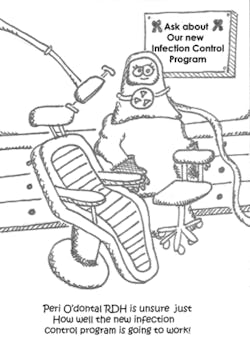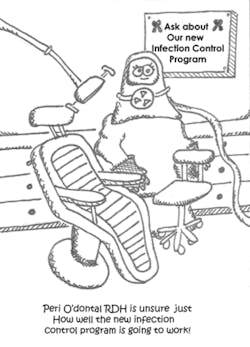Pink in the sink
About a week ago, I had an opportunity to chuckle at work, based on a female client’s answer to a question I asked her about toothbrushing technique. Here was her unusual response: “My last dentist taught me to brush Gum to Tooth, like Georgia Tech.” (For those of you who are unfamiliar with Georgia Tech, we Atlantans love this university almost as much as we love cornbread and grits.) “Gum to tooth?” I questioned her, and she replied, “Yes, I brush down from the G(eorgia)um and onto the T(ech)ooth.”
Later on that same day, another adult recare client announced that something was amiss in the area of the upper left quadrant because the client reported that she saw “pink in the sink” when she brushed this particular area. After circumferential probing, I recorded a 6 mm (localized) periodontal pocket and spontaneous bleeding on the distobuccal surface of tooth No.14, and a 7 mm periodontal pocket on the mesiobuccal of tooth No.15. All other probing depths throughout the mouth were 3to 4 mm or less.
Here are two entirely different teaching opportunities, one in which humor sets the stage for instruction, and the other in which the “pink in the sink” alarm went off, telling me that the client is already motivated and ready to ditch the pink!
In the first scenario, I had fun with this client. She was at low risk for dental caries and periodontal disease, so I spent some time educating her about the new high-end power brushes on the market. There are two brands in particular that are both well rated that I decided to recommend. As a fitness instructor, she was interested in listening to me talk about the evidence-based research that has demonstrated the effectiveness of high-end power brush models. Although research on the effectiveness of power brushes is ongoing, it is probably safe to say that some of these high-end brushes remove more plaque when compared to manual toothbrushes, especially when used according to instructions and for a full two minutes.
The second scenario I refer to as the mystery of the “pink in the sink.” After performing a comprehensive periodontal exam and reviewing the adult client’s printed risk assessment score, I concluded that this client was at high risk for periodontal disease. The client was a heavy smoker, was recently diagnosed with Crohn’s disease, and her mother and father had lost several posterior teeth to periodontal disease. In addition, the client sought preventive care only irregularly and her compliance with oral hygiene measures was poor, which resulted in a low standard of oral hygiene.
I was a lucky clinician that particular day. Instead of the usual one-hour recare appointment, the client following the lady with “pink in the sink” had cancelled, so I was well aware that I had sufficient time to take and study a periapical film and perform needs-related treatment planning. The attending dentist ruled out occlusal trauma in this area, so I now understood the risk factors at hand. The toughest part of the visit was about to begin and, in my opinion, here’s the ultimate kicker: How do we help clients commit themselves and take ownership of their conditions?
Before we come up with a workable strategy, let’s back up a minute and think this scenario through. OK. This client is intelligent; she’s well educated and concerned about the bleeding in the upper left quadrant. That’s a great start. Let’s not underestimate her and, instead, let’s try to function as a skilled helper and try to get her to agree to ongoing commitment that includes a long-range plan.
The hygienist might say something like this: “Mrs. PinkSink, as your dental hygienist, I am concerned about this area on the upper left, which you say bleeds whenever you brush. Let me show you something. (I pull out the intraoral camera wand and place the probe in one of the deep pockets.) Do you have any idea why this area is bleeding? If I told you that bleeding while brushing or probing like I’m doing indicates active infection of the gum tissue, what would you think? Mrs. PinkSink, tell me what you can remember about your mother’s and father’s tooth loss from gum disease.” Note that I am using open-ended questions - ones that require more than yes/no answers. I may have already asked too many questions. I don’t want the client to feel that she is on trial!
To save a bit of time, we then go over the client’s printed risk assessment score for periodontal disease. I also discuss with her the accumulated evidence that seems to indicate that about 30 percent of periodontal disease is genetically driven, and that smoking is a risk factor that adds to her already increased risk of disease due to genetic susceptibility. Once you have presented the “evidence,” the tough part begins! You now have to establish short- and long-term therapeutic goals and get the client to accept them.
Based on many years of clinical experience, I have found that it’s relatively easy to get patients to commit to short-term therapeutic goals as long as I handle the financial commitment with fine kid gloves. I’ll be the first to admit, however, that I’m not as convincing as the late Dr. Bob Barkley, one of the pioneers in preventive dentistry in the late 1960s who used to serve his clients plaque on a cracker or quote funny expressions like “There’s no point in building a mansion in a swamp.” If your communication skills are solid and you use visuals in your treatment presentations, most times your clients will respond, especially if you show them that you are a good listener and care about human relationships.
Long-term commitment to the maintenance of a periodontal client requires some advanced communication skills. Dental hygienists can excel in this area and are far better than a lot of dentists in their ability to focus on the human touch. Like many practicing physicians, dentists are sometimes too preoccupied with becoming proficient in dental technology, restorative aspects of care, and practice management issues.
In getting your clients to commit to long-term periodontal maintenance and appropriate home-care techniques, determine if the client is ready to commit to change. In no uncertain terms, make sure the client understands that there is no “quick fix” for periodontal disease. As a “quick fix” society, Americans are notorious for starting something and then dropping out. Cost issues for periodontal maintenance should be clearly presented, and it would be a good idea to walk a patient through a five-year commitment of periodontal maintenance with or without dental insurance. Clients want to know if their total investment is cost-effective.
Clients must be persuaded to understand that their commitment will have far-reaching benefits that will ultimately outweigh the cost of care. Help your clients foresee the consequences of their choices and help them visualize an oral cavity in which “gumbugs” are significantly reduced in number. Help clients set appealing goals such as lower annual dental bills over a lifetime, better overall health, and the possibility of retiring with an intact set of teeth! In addition, you can present self-contracts to clients in which you act as a facilitator and contact the client periodically to make sure that the commitment is still alive.
About six months ago, I attended a continuing education course given by Mary Osborne, RDH. She has more than 35 years of experience in clinical hygiene and is a lifelong student of effective communication and relationship building. Mary impressed me most when she emphasized the importance of managing obstacles that are an inevitable part of client care. How can you help a client plan to manage obstacles? Spend some time with your client in developing simple, manageable goals, and design a set of simple strategies to accomplish them.
An old and trusted friend of mine, Joan K. Fitzgerald, RDH, is currently experimenting with a vision tool that was designed by Richard Brooke and presented in his book Mach II Starring You. Joan encourages her clients to write a vivid description of their perfect oral and overall health. She asks them to write this description in the present tense, as if it were already true. She believes that the mind cannot distinguish between what is real or vividly imagined (like coming to tears while watching a movie). She asks her clients to read their vision statement every morning and night. Joan believes that this constant reminder has the effect of turning up their “thermostat,” so to speak. In conjunction with other approaches, Joan is seeing positive results in terms of the client’s commitment to periodontal therapy and self-care. Joan describes herself as a visionary clinician and she is not afraid to try something new. She indicated to me that she is most grateful to be living in a free country where she can work in a private practice that gives her freedom to explore new approaches to client commitment. Joan believes strongly in evidence-based care, but it is far more important to her that therapy is “significant” for her clients.
Here’s another example of a creative way that a somewhat wacky entrepreneur helped his employees commit to a healthier lifestyle. An endocrinologist scientifically designed an office environment in which his staff exercises while they work! They walk on a moving treadmill that serves as both desk and computer platform. When he and his colleagues hold an in-office meeting, they walk on a two-lane walking track that circles most of the 5,000-square-foot office space! What’s the message here, and how does it apply to client commitment to long-term periodontal care? Make sure your commitment to comprehensive periodontal care is lifelong and consistent, and find creative ways to be a good role model and change-agent for your clients.
Lynne H. Slim, RDH, BSDH, MSDH, is a practicing hygienist/periodontal therapist who has more than 20 years experience in both clinical and educational settings. She is also President of Perio C Dent Inc. (Perio-Centered Dentistry), a practice management consulting firm that specializes in creating outstanding dental hygiene teams. Lynne is a member of the Speaking and Consulting Network (SCN) that was founded by Linda Miles and has won two first place journalism awards from ADHA. Lynne is also owner/moderator of a periodontal therapist yahoo group: http://yahoogroups.com/group/periotherapist. She can be contacted at [email protected].

